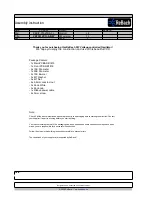
Date:
11-04-20
Project:
Remark:
File:
RBDIY-CTSVCOA-1.1
Version:
1.2
Title:
CATCH VCO-A DIY
HW version:
1.1
REF:
Page:
7
Tuning
For good results, please let the VCO warm up for at least 5 minutes!
1
2
3
4
5
6
7
8
9
10
11
12
13
14
15
Note: A
Note: B
Note: C
Note:
Assembly instruction
To calibrate this VCO, you need either a tuner or a different VCO or keyboard/Synth. Your second
VCO or SYNTH is used as the reference source!
Set the two trimmers (TR1 & TR2) in the middle position (ex works they are in the middle position)
Connect the VCO 1V / Oct input to a keyboard CV-note output or Midi interface CV output (1V / Oct outputs)
Connect a tuner to the TRI output of the VCO (see note A)
Connect the power supply ribbon cable to the VCO (make sure the red band is on the right hand side)
Turn on the power and let the VCO warm up for at least 5min (at normal room temperature – plm 20C)
Set the TUNE knob on the VCO front approximately to the middle position and press C3 on the keyboard.
adjust the TUNE knob further until the VCO and your reference have the same frequency (Low tracking
adjust. See also note B)
Press the keyboard C3 and measure or listen to the frequency. Then press C2 and C1, they must exactly 1
or 2 oct lower. If the C2 and C1 have a lower frequency then adjust TR1 slightly up (CW). are the C2 and
C1 higher than each other? Adjust TR1 slightly down (CCW). After every time you adjusting TR1 you have
to adjust the TUNE knob again so that you are back at the same freq as the reference source !!
Press the keyboard C5 and measure or listen to the frequency. then press C4 and C3. if the C4 and C3
have a lower frequency then adjust TR1 slightly up (CW). C4 and C3 are higher then adjust TR1 slightly
down (CCW). then check C2 and C1 again. After every time you adjusting TR1 you have to adjust the
TUNE knob again so that you are back at the same freq as the reference source !!
Repeat step 7 as many times as necessary until all octaves are equal.
Adjust the TUNE knob on the front 2 oct lower and repeat steps 6 and 7. if they are good go to step 10
Now adjust the TUNE knob on the front 4 oct higher and press C3 on the keyboard. Adjust the TUNE knob
further until the VCO and your reference have the same frequency
(High tracking adjust. See also note C)
Press the keyboard C3 and then C2 and measure or listen to the frequency. Now press C5 and C6. C5 and
C6 have a lower frequency adjust TR2 than slightly up (CW). If C5 and C6 have a higher frequency, adjust
TR2 slightly down. After every time you adjusting TR2 you have to adjust the TUNE knob again so that you
are back at the same freq as the reference source !!
Repeat step 12 as many times as necessary until all octaves are equal and check C2 and C1 again !
If the low octaves are slightly out of tune after step 12, go through step 7 again
If necessary, go through all steps several times if the octaves continue to have mutual differences
If you do not have a tuner, connect a second VCO or SYNTH which receives the same CV-Note signal. Mix
the output of both so that you can hear and compare both signals at the same time ! If you use a second
VCO, it must be properly adjusted!
Low tracking adjustment takes place via TR1
High tracking adjustment takes place via TR2. This trimmer only affects high frequencies (approx C5 or
higher) . At low frequencies, this trimmer will have no significant influence
No rights can be deducted from this document.
© 2020 ReBach –







